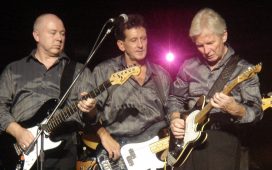‘Well, sometimes it’s better not to say anything, at all,” sings Nick Cave, his voice hoarse, plaintive, a hair’s breadth away from breaking. After the unimaginable happened in July 2015 – when his 15-year-old son Arthur died after falling from a cliff in Brighton – Cave, for a while, went silent. He put the final touches on the album he had been writing, Skeleton Tree, then stepped out of the limelight.

This self-imposed exile continued until last September 2018, when Cave revealed his first entry for the Red Hand Files, a website that invites fans to ask him anything. Since then, words have been spilling out of him: on top of his warm, wise turn as an agony uncle, he went on a tour called Conversations based around unscripted discussions with his audience. Finally, this October, came Ghosteen, his 17th album with the Bad Seeds and the first written entirely following his son’s death.
Cave’s newfound volubility doesn’t extend to this double album, which has long, sombre, instrumental set pieces reminiscent of David Bowie’s Low. At times, words are repeated to such an extent that they become unmoored from meaning: “Oh my, oh my, oh my, oh my,” he intones on Leviathan. Emerging from this stark backdrop are some of the most beautiful lyrics of Cave’s career: from terrifying Blakean imagery (“the burning horses and the flaming trees / As a spiral of children climb up to the sun”) to apocalyptic visions (“sea creatures rise out of the sea … Everyone begins to run”).
Guitars and drums are also almost entirely stripped away. (Cave has explained that “the drums anchored the songs to the ground and didn’t allow them to float”.) Instead, there are spectral strings and synths, bells, electronics, a smattering of piano notes. The slow, meditative sound echoes the album’s themes of acceptance; relative calm after the angry, anguished Skeleton Tree. There are moments when Cave appears to be slowly coming to terms with what has happened: “Sometimes a little bit of faith can go a long, long way,” he sings. The Ghosteen of the title, a manifestation of Arthur’s presence, at one point seems to comfort him: “I am beside you.”
But it’s not as simple as a linear passage from the darkness into the light. The songs on part two, complicate everything we have just heard. In the spoken-word Fireflies, Cave speaks of dying stars and fearing his dreams. In Hollywood, the 14-minute epic that closes the album, the drums kick in, anchoring the music back down to the ground. One of the final lines is: “I’m just waiting now, for my place in the sun / And I’m just waiting now, for peace to come.” It teeters between hope and despair. The yearning and pain in his voice recall Bowie again, but this time the Bowie of Blackstar.
And yet within the same song lies a resolution of sorts. Cave’s voice reaches a brittle, aching falsetto as he tells the Buddhist story of Kisa Gotami, who is told she can save her sick baby only if she finds a mustard seed from a house where no one has died. But she can’t, because in every house she knocks at there is someone who’s experienced loss. “I realised that I was not alone in my grief and that many of you were, in one way or another, suffering your own sorrows,” he wrote in his first post on Red Hand Files. “I felt very strongly that the communal suffering, and our ability to transcend it, was the thing that held us together.” This realisation brought him back to songwriting: instead of feeling demoralised by suffering, he tried to find strength in it.













